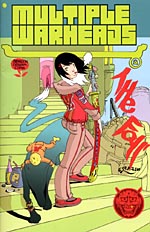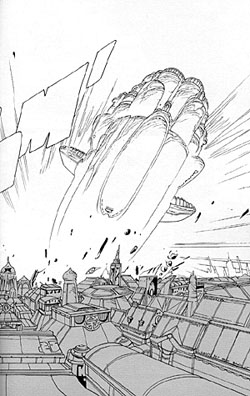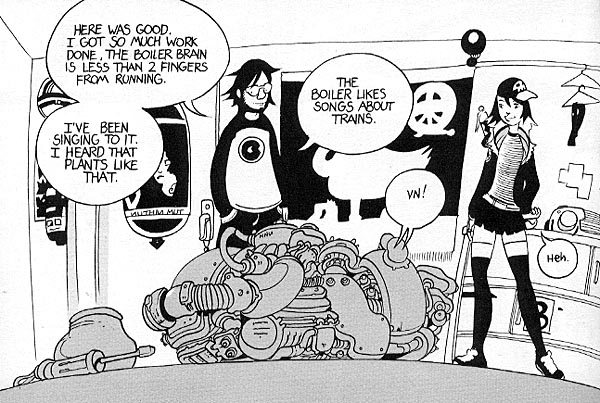 By Brandon Graham
By Brandon Graham
48 pages, black and white
Published by Oni Press
Have you ever read something that seems eerily familiar, but you can’t even begin to place where you think you’ve seen it before? That was the problem I had when I first read Multiple Warheads by Brandon Graham, as its inaugural issue kept reminding me of something that I couldn’t place my finger on. It wasn’t until over a week later that it finally began to sink in. It wasn’t that I had read something like it before, but rather a wish to see this kind of book that was only now being fulfilled. Only in the case of Multiple Warheads, it’s probably a wish you didn’t even know you’d made.
Sexica is an organ smuggler, sneaking unbreakable hearts and stomachs that turn waste into gold out from the wastelands into the center of Dead City, so she can sell them on the black market. Her boyfriend Nikoli is now part werewolf, dreaming the strange narratives of the wolf whose organ was attached to him as a birthday present from Sexica. And the outside world? Well, after the war between the werewolves and aliens out in deep space, it smells like radiation and dust and broken dreams. Some day, though, Sexica and Nikoli will make it to Impossible City, provided they can just survive in Dead City a little longer.
 The story of Multiple Warheads feels in many ways like a strange combination of a half-remembered dream and a general sense of wistfulness. Right from the start, with Sexica thinking about ghost ships crashing through the planet’s atmosphere on autopilot from the long-ended war, you get a real sense of the world that Graham’s created. It’s familiar but not at the same time, with pieces of our present day scattered in ruins and shards across Multiple Warheads. With grafitti-covered statues of Communist leaders and ancient domes side-by-side robotic guards and impossible biological creations, it’s this strange juxtaposition of the future and now that begins to bring that strange sort of feeling across. What really brings it all into focus, though, is Graham’s writing of Sexica’s narration for the book. He has a real gift with words, creating new phrases or meanings in ways that make perfect sense while maintaining their uniqueness. The narration comes across almost like poetry as well, though; it’s clearly a narrative, but there’s a certain evoking of imagery that comes with his descriptions. Talking about host bodies for gods that want to walk the earth, or the dead husks of ships crashing through the sky, and you get a genuine sense about the strangeness of this world. It’s entrancing, and it amazes me that after just 48 pages I not only feel like I already know so much about Multiple Warheads, but that I am desperate for much more.
The story of Multiple Warheads feels in many ways like a strange combination of a half-remembered dream and a general sense of wistfulness. Right from the start, with Sexica thinking about ghost ships crashing through the planet’s atmosphere on autopilot from the long-ended war, you get a real sense of the world that Graham’s created. It’s familiar but not at the same time, with pieces of our present day scattered in ruins and shards across Multiple Warheads. With grafitti-covered statues of Communist leaders and ancient domes side-by-side robotic guards and impossible biological creations, it’s this strange juxtaposition of the future and now that begins to bring that strange sort of feeling across. What really brings it all into focus, though, is Graham’s writing of Sexica’s narration for the book. He has a real gift with words, creating new phrases or meanings in ways that make perfect sense while maintaining their uniqueness. The narration comes across almost like poetry as well, though; it’s clearly a narrative, but there’s a certain evoking of imagery that comes with his descriptions. Talking about host bodies for gods that want to walk the earth, or the dead husks of ships crashing through the sky, and you get a genuine sense about the strangeness of this world. It’s entrancing, and it amazes me that after just 48 pages I not only feel like I already know so much about Multiple Warheads, but that I am desperate for much more.
Graham’s art is at a glance a sparse, straight-forward style using a minimum number of lines to define his characters. It’s deceptively simple looking, though, with the more you look the greater the detail created. From cityscapes of ruined domes and buildings, to the menacing form of a “snake by numbers” you are able to see the careful craft put into each image, each piece carefully constructed to work with those around it. It wasn’t until I re-read Multiple Warheads #1 that I really saw just how much background detail is added in, from labels for new brand names on beer bottles, to graffiti scrawled on the roofs of background buildings, to the carefully drawn mechanics of an engine. The more I see of Graham’s work, the more impressed I am; you continually notice new bits and pieces, be it a discarded bird-shaped helmet to discarded propellers littering the streets. It’s a handsome comic, and with its thick paper stock and slick cover, it’s a physically pleasing object to boot.

At first, when I was trying to figure out why Multiple Warheads felt so familiar, I kept trying to compare it to all sorts of source material, from Moebius’s The Airtight Garage and Makoto Yukimura’s Planetes, to Paul Pope’s THB and Yoshitoshi ABe’s NieA_7. In the end, though, I realized that the big thing that it had in common with all of those other works was a sharply realized sense of world building, that Graham had created a rich culture that his story hangs upon. Like all the rest of these, Multiple Warheads is the kind of world that you want to see more of, for both its similarities and its differences to our own. It’s not really quite like anything else out there, in the best possible way. Absolutely check this book out, and here’s hoping it’s not too long until we get another installment.
